OVERVIEW
Whether it’s tackling a consumer backlash and reputation damage after a product recall, trying to rectify decreased trust and liability challenges following a data breach or staying one step ahead of industry disruption that’s threatening market share, the risks today’s business leaders face continue to evolve.
Aon’s 2019 Global Risk Management Survey found that risk-readiness – the understanding of the threats confronting organizations and their preparedness for dealing with them – is at its lowest level in over a decade. Global economic uncertainty and transformative technologies can pose risks that are difficult to anticipate, prepare for and mitigate.

In addition to decreased levels of risk-readiness, the findings also show that – despite an increase in data available – many organizations aren’t yet taking full advantage of analytics tools that can help them better identify and assess risks on the horizon. Alarmingly, less than a quarter of survey respondents said they quantify their top 10 risks.
Looking at the major risks and how industries prepare to deal with them reveals a variety of valuable lessons for organizations. Technology can be a part of the solution, but additional approaches are needed to stay ahead, such as industry collaboration, openness to new business models, staying connected to customer expectations and finding new solutions for common industry challenges.
IN DEPTH
As new risks emerge and established risks evolve, organizations can find it difficult to be risk-ready. That readiness can be essential, however, to dealing with changing market conditions, new competition and a host of external forces (including natural disasters and manmade perils, such as terrorism and cyber attacks) confronting today’s businesses.
Here’s a look at five industries’ risk-readiness levels and some of their approaches to best prepare for the unique risks they might face.
Power And Utilities
The top risk for the power and utilities industry was regulatory and legislative changes. Companies in this industry must track market and trade surveillance while adhering to stringent standards for safety, environmental responsibility and price reporting.

The additional risk of wildfires has recently emerged as people and property continue to move into at-risk areas. Recent experiences with damaging wildfires linked to power lines in Australia, California and Texas have seen many power and utilities companies looking to mitigate exposures and increase their risk resilience. For many, the approach involves creative, technology-based solutions to address common environmental challenges the industry faces.
The Edison Electric Institute, an association of U.S. investor-owned electric companies, launched a task force of CEOs to explore potential solutions to wildfire exposure through regulation and technology. Among the tech solutions used to identify and address wildfire exposures is the use of drones and other camera or sensor technologies.
A critical element in managing wildfire risks remains one of the most basic: vegetation management. “Proper vegetation management is the key,” says Mark Fishbaugh, U.S. power practice leader at Aon. “We cannot broadly say that the utility lines are faulty or that safety programs aren’t in place. For many of these incidents, it’s basic blocking and tackling of vegetation.” Southern California Edison, an electric services company, has pledged to safeguard its system against wildfire by protecting and inspecting crucial sites and equipment using infrared equipment, for example, as well as aggressively addressing and managing vegetation issues.
Printing And Publishing

Few industries have faced greater disruption from the digital revolution than printing and publishing. The industry has been forced to confront disruptive technologies that have changed the way content is created, distributed and consumed.
Yet many publishers have adapted to the disruption. They’re embracing the ability to expand beyond print publishing into digital formats to reach new – and broader – audiences.
As they’ve embraced digital, thriving publishers have adapted design and content to new formats, such as mobile devices, while also adjusting pricing models to attract online consumers. Many have learned to view print and digital as complementary, with some digital publishers even embracing print opportunities.
Publishers that have successfully weathered the digital disruption have demonstrated two fundamental ways any business can address changing markets or increased competition: embrace new technologies and business models and demonstrate an openness to incorporating new ideas and technologies as consumer behavior shifts.
Banking

Banks are among the industries relying heavily on technology to increase efficiency and competitiveness while handling considerable volumes of customer data. Unsurprisingly, cyber attacks and data breaches were the top-ranked risk by banking industry respondents in this year’s survey.
It’s also not surprising that cyber criminals have a keen interest in financial institutions. Increased connectivity with consumers, who progressively rely on online banking, has greatly expanded possible points of entry into bank systems.
Banks have responded to the growing threat by increasingly collaborating across the industry to improve their defense to cyber threats. They’ve also worked closely with law enforcement to identify threats and maintain a constant focus on improving security.
However, it’s not just the financial sector: every organization is a potential cyber attack victim, and those industries that rely heavily on digital technology are at particular risk. According to the Ponemon Institute, a data breach in 2018 cost, on average worldwide, $3.86 million, up 6.4 percent from the previous year. To address the exposure, organizations should adopt a comprehensive approach to cyber threats: continually assessing their risk profiles, addressing vulnerabilities and proactively addressing cyber defenses.
Retail Trade

Retailers face a variety of threats, including changing consumer purchasing habits and threats to brand and reputations in the era of social media.
Online shopping continues to boom. Online retailer Alibaba clocked in a record $30.8 billion in sales on Singles Day in 2018. In the U.S., 2018’s Black Friday online sales hit $6.22 billion. A few days later, Cyber Monday sales reached $7.9 billion.
The impact on many brick-and-mortar retailers has been devastating, with U.S. retailers announcing plans to shutter nearly 6,000 shops during the first four months of 2019, a number already surpassing the 2018 total of 5,854.
Retailers that have survived – and succeeded – in the face of online competition have done so by focusing on customer experience and embracing opportunities that technology provides. They’ve also adjusted their talent focus to keep pace with the new skills needed in the digital era.
Meanwhile, as they look to protect their brands against threats, many retailers have made reputation risk a part of their corporate strategy and planning, with protocols in place to quickly respond to reputation threats. They’ve also recognized the need to actively manage the customer experience and respond quickly to customer concerns.
Pharmaceuticals And Biotechnology

Aon’s 2019 Global Risk Management Survey shows that for the pharmaceutical and biotechnology industries in particular, “Loss of Intellectual Property and Data” is a key risk – with respondents ranking it number 11 – considerably higher than the global ranking of the same risk (at number 34). Pharm and biotech companies devote considerable resources to new product development, resulting in a high value for their intellectual property (IP).
Effective patent management is one way the pharma and biotech industries can protect their intellectual property. Other methods including securing systems to protect IP against data theft, and industrial espionage are also essential.
However, to protect IP, a company needs to understand exactly what its IP is as well as its value.
Across industries, many companies are struggling to make this assessment. “Very few companies recognize the value of their IP, nor have they secured an IP strategy that mirrors their long-term corporate strategy in order to maximize this value,” said Lewis Lee, chief executive officer of Intellectual Property Solutions at Aon.
Applying Lessons Learned To Critical Threats
The most critical threats facing specific industries might vary, but lessons can be applied across industries.
As they look to address the vulnerabilities that threaten their own businesses, organizations can benefit by examining how others are addressing major risks and elevating their risk management function to the enterprise level.
But to tackle a risk effectively, a company must first understand it. Rory Moloney, chief executive officer of Global Risk Consulting at Aon, underscores the importance of data in this process: “As risks shift, insights from data and analytics will continue to be critical in helping organizations across industries glean the right insights at the right time to help protect their bottom lines.”
See how risks have evolved since Aon’s 2017 Global Risk Management Survey.
The post How Risk-Ready Are You? Lessons From 5 Industries appeared first on The One Brief.
